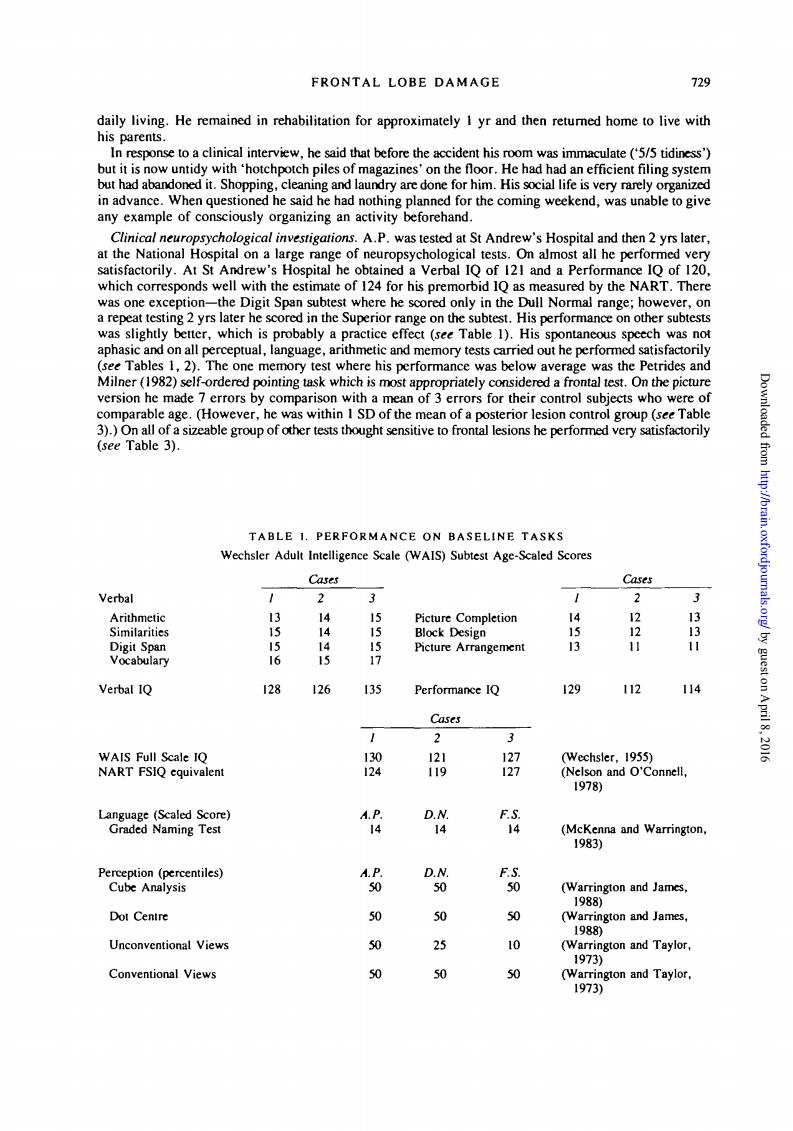正在加载图片...

FRONTAL LOBE DAMAGE 729 re the accident his clea inand laundry areon for him.rarely of said he h d for the coming weekend,was unable to give ologcalarp all and then 2 yrs later satisfactorily.At St Andrew's Hos pital he obt ed a Verbal IQ of 121 and a Performance IQ of 120 oy the r the Digi a repea 2 yrs la e scored in the Superior range on the otest.His performance on oth subtest nd on a uals proba metic and m ).out he The one mem ory est where his performance was bel w ave age was the Petrides anc nade errors by c for their c the p comparable s within I SD of the mean of a posterior lesion control group(see Table lesions he performed very satistactonly PERFORMANCE ON BASELINE TASK Cater Verbal 3 3 Picture Completion 14 13 212 11 cabulary Verbal IQ 128 126 135 129 112 114 Cases NARTSI 2 17 ed Namins Tet PCeia0fesniles (War and Jams. Dot Centre 50 50 6 Unconyentional views 西 25 0 9gionanNhne ton and Taylor 973 Conventional Views 0 50 50 ton and Taylor, 1973) FRONTAL LOBE DAMAGE 729 daily living. He remained in rehabilitation for approximately 1 yr and then returned home to live with his parents. In response to a clinical interview, he said that before the accident his room was immaculate ('5/5 tidiness') but it is now untidy with 'hotchpotch piles of magazines' on the floor. He had had an efficient filing system but had abandoned it. Shopping, cleaning and laundry are done for him. His social life is very rarely organized in advance. When questioned he said he had nothing planned for the coming weekend, was unable to give any example of consciously organizing an activity beforehand. Clinical neuropsychological investigations. A.P. was tested at St Andrew's Hospital and then 2 yrs later, at the National Hospital on a large range of neuropsychological tests. On almost all he performed very satisfactorily. At St Andrew's Hospital he obtained a Verbal IQ of 121 and a Performance IQ of 120, which corresponds well with the estimate of 124 for his premorbid IQ as measured by the NART. There was one exception—the Digit Span subtest where he scored only in the Dull Normal range; however, on a repeat testing 2 yrs later he scored in the Superior range on the subtest. His performance on other subtests was slightly better, which is probably a practice effect (see Table 1). His spontaneous speech was not aphasic and on all perceptual, language, arithmetic and memory tests carried out he performed satisfactorily (see Tables 1,2). The one memory test where his performance was below average was the Petrides and Milner (1982) self-ordered pointing task which is most appropriately considered a frontal test. On the picture version he made 7 errors by comparison with a mean of 3 errors for their control subjects who were of comparable age. (However, he was within 1 SD of the mean of a posterior lesion control group (see Table 3).) On all of a sizeable group of other tests thought sensitive to frontal lesions he performed very satisfactorily (see Table 3). TABLE I. PERFORMANCE ON BASELINE TASKS Wechsler Adult Intelligence Scale (WAIS) Subtest Age-Scaled Scores Cases Verbal Arithmetic Similarities Digit Span Vocabulary Verbal IQ WAIS Full Scale IQ NART FSIQ equivalent Language (Scaled Score) Graded Naming Test Perception (percentiles) Cube Analysis Dot Centre Unconventional Views Conventional Views 13 15 15 16 128 2 14 14 14 15 126 15 15 15 17 135 130 124 A. P. 14 A. P. 50 50 50 50 Picture Completion Block Design Picture Arrangement Performance IQ Cases 2 121 119 D.N. 14 D.N. 50 50 25 50 127 127 F.S. 14 F.S. 50 50 10 50 14 15 13 129 Cases 2 12 12 11 112 3 13 13 11 114 (Wechsler, 1955) (Nelson and O'Connell, 1978) (McKenna and Warrington, 1983) (Warrington and James, 1988) (Warrington and James, 1988) (Warrington and Taylor, 1973) (Warrington and Taylor, 1973) by guest on April 8, 2016 http://brain.oxfordjournals.org/ Downloaded from